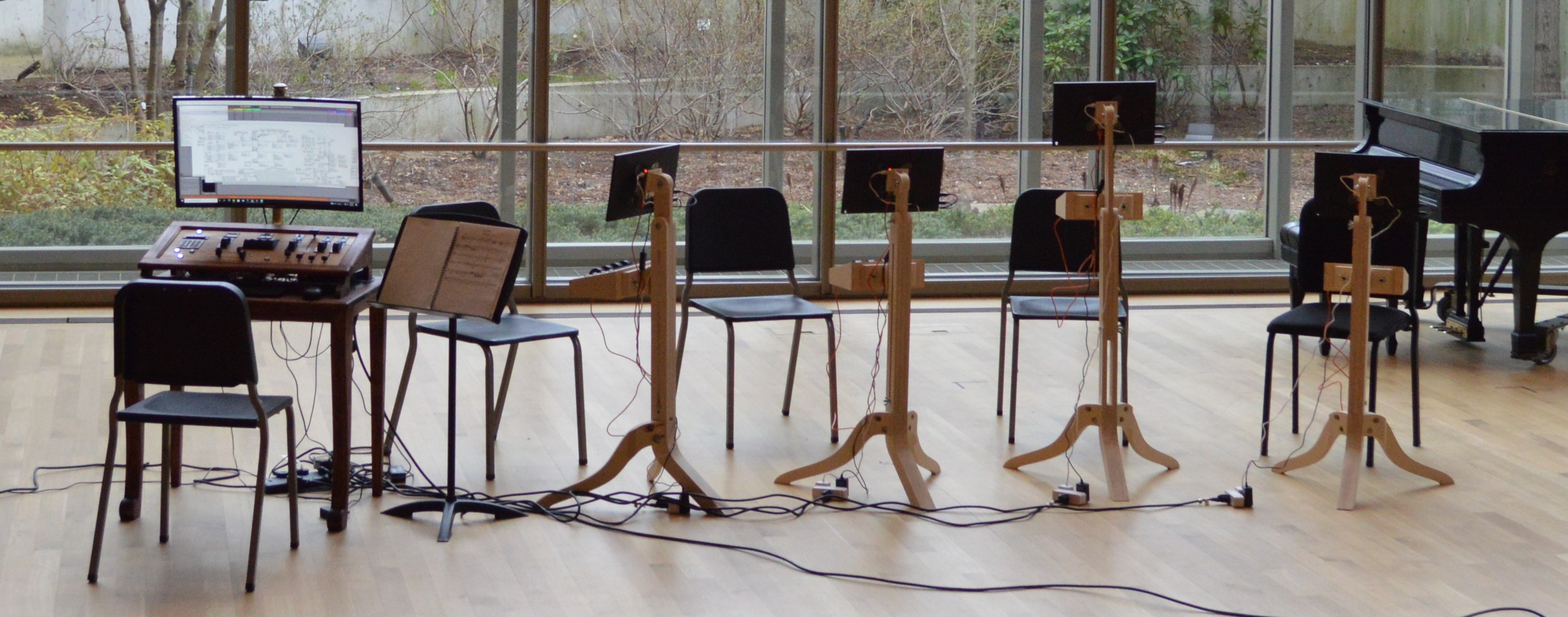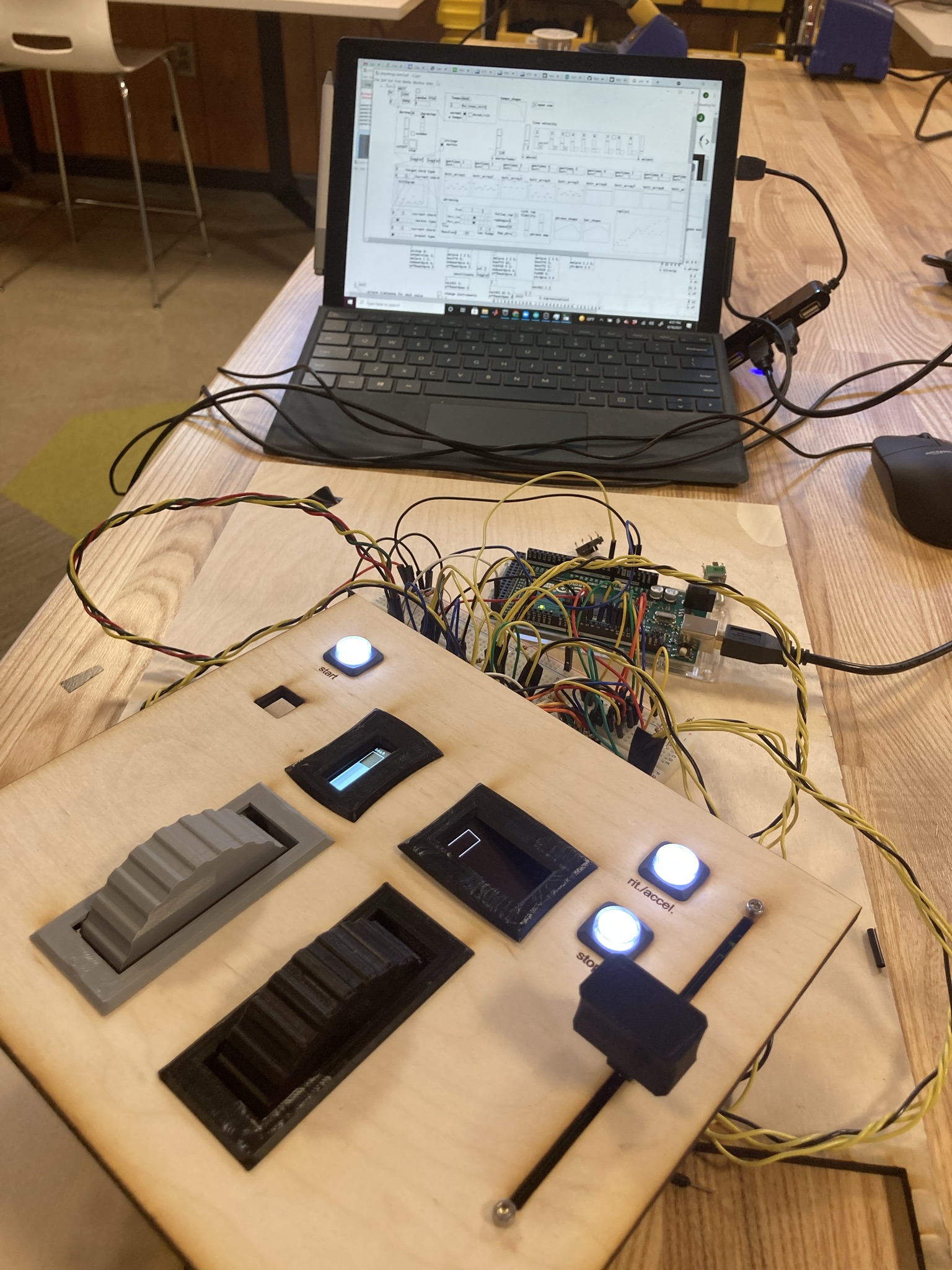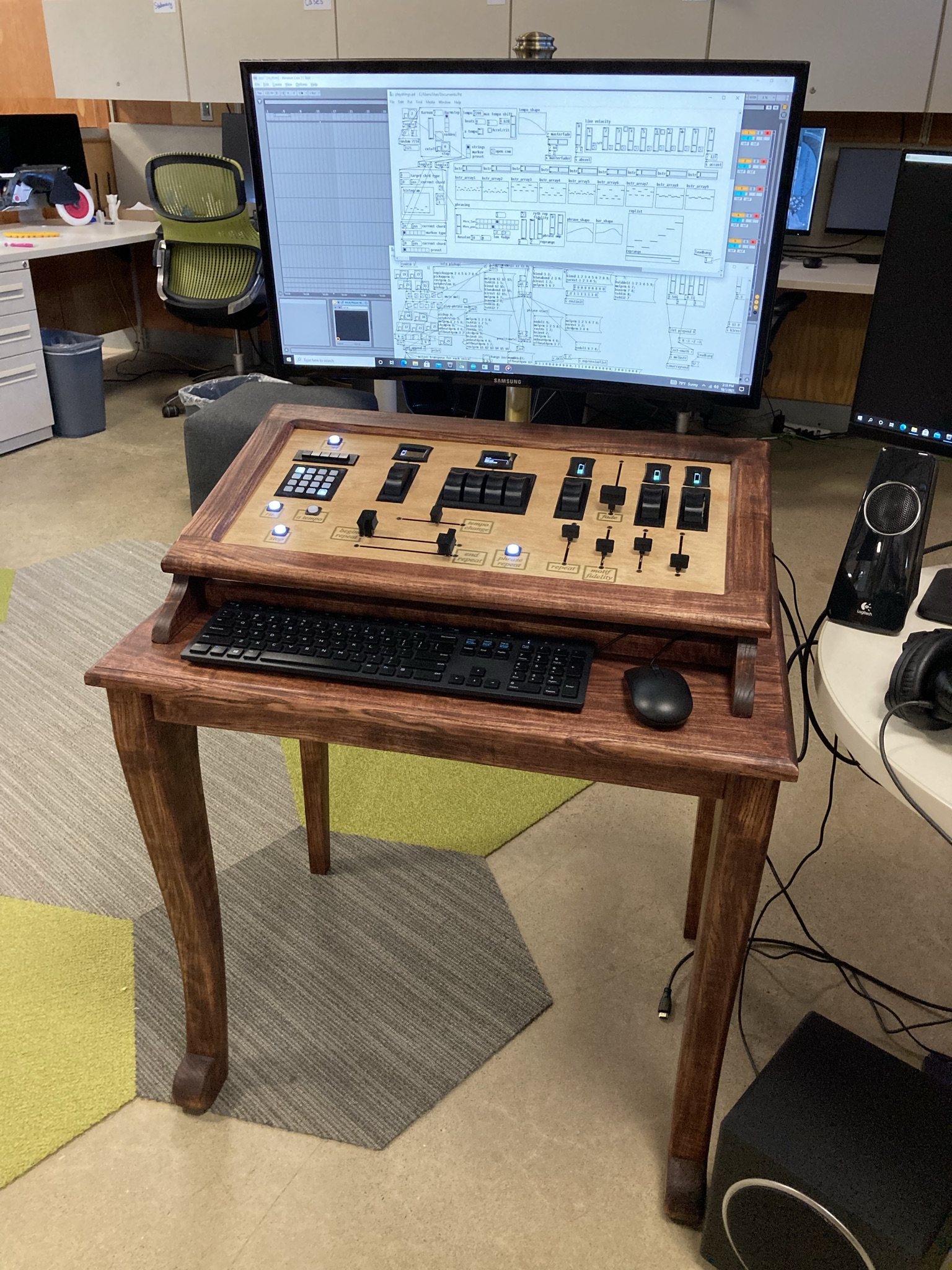 |
 |
 |
 |
 |
 |
The Composer

The Composer is a physical interface for exploring live, collaborative composition and performance. It consists of two parts: the principal unit, and the smart stands. The principal unit features a control panel with rotary controls, sliders, and buttons that allow the performer to adjust the parameters of a composition as it is being composed. The principal unit also serves as a DAW (digital audio workstation) which can play one or more parts of the composition via virtual instruments. The “smart” music stands are wirelessly networked with the principal unit. The smart stands can control composition parameters for one part, while notating that part as it is composed by the principal unit, allowing the user to see the part they are composing, or to play along extemporaneously.
The Composer is an instrument that blurs the usual lines between composer, performer, and audience. The prior work of Berezovsky and Cooke led to algorithms for music composition that could generate music in different styles by setting parameters governing harmony, melody, and rhythm. The Composer takes advantage of these algorithms to give real-time control over an unfolding composition to a composer onstage, to musicians actively playing that composition, or to members of the audience. This way of music-making adds an element of improvisation, and challenges assumptions such as the idea that performers are just conduits for a great composer’s intentions, or that the job of an audience member is to sit and passively listen, instead of actively engaging with the music.
The Composer is so named in analogy to the Computer. Before the invention of the electronic computer, a “computer” was a person who performed mathematical computations. With the widespread adoption of electronic computers, a “computer” came to refer to the tool that allowed people to perform computations more efficiently and in new ways. Similarly, the Composer is not intended to remove human creativity from the creation of music, but to render music-making more accessible and allow exploration of new ways of making music.


The communication between the principal unit and the smart stands allows for flexible, collaborative control over the composition and performance process. A given composition parameter can be controlled automatically by the principal unit, by the user of the principal unit, and the users of the smart stands. The design of the collaborative controls allows the same parameter to be seamlessly adjusted from multiple sources. These controls are based on rotary encoders, with the controlled parameter displayed in a small OLED display above the control. This mechanism allows parameters to be controlled collaboratively by multiple users and by the algorithm. Since the wheel allows for continuous adjustment, if a parameter changes, only the OLED display is changed, not the physical wheels. And if multiple users adjust a parameter at the same time, the OLED display changes to reflect the sum of all these changes.
The composer can be used in multiple ways. It can be used for stand-alone composition via the Principal unit, composition via the principal unit with extemporaneous performance by human performers, combination of extemporaneous and rehearsed parts, and composition including audience participation. It also can be used as an educational or practice tool for learning about composition, ensemble playing, and more.
In April 2022, the Composer was featured in a performance entitled “Crystals of Sound” at the Cleveland Institute of Music. The performance consisted of eight pieces that all included the Composer, or music previously composed by the same algorithms. Videos of the performance are available here:
The performance begins with an introduction from Berezovsky and Cooke explaining the underlying ideas behind the project, and the visualizations that accompany the music. The first piece, “Broken Symmetry,” is for percussion only and is played extemporaneously by Berezovsky on the Composer, demonstrating the rhythmic capabilities of the Composer.
The next piece “Harmonicity” is also played on the Composer by Berezovsky. This piece is for bugle, demonstrating a simple harmony based on a single triad. The next piece, “Renormalization,” mixes human and computer performance. Here, Berezovsky uses the Composer to generate a piece in a pentatonic harmony for viola and harp. The Composer synthesizes the harp part, and the viola part is streamed to a Smart Stand, and performed extemporaneously by Cristina Micci-Barreca (CIM).
The next three pieces are performed by Huan Zhang (CIM) on the piano. These were composed beforehand using the Composer algorithms. The pieces “Goldstone Variations 1.49” and “Goldstone Variations 3.106” are both based on Bach’s “Goldberg Variations”. Each follows the same harmonic progression as the Goldberg Variations, but with a uniquely generated melody and rhythm that mimics the style of the first and third Goldberg Variation respectively. The “49” and “106” refer to the fact that these are the 49th and 106th variations composed by the algorithm in this way. The other piano piece, “Universality” is composed using physics-based harmonies that arise directly from a model that treats musical harmony as an ordered phase of sound.
Next on the program is a string quartet, “Vortex Strings,” performed by CWRU students, Lilyanne Dorilas and Bryan Sun on violin, and Ethan Cogdill on cello, with Micci-Barreca again on viola. This piece is composed by Berezovsky on the composer, and played extemporaneously by the musicians. The first two movements of the piece are based on physics-derived harmonies, while the last movement returns to familiar tonal harmonies specified by Cooke’s Markov matrices.
The next piece, “Criticality,” features Lilyanne Dorilas again on the violin, playing a solo part written by Alex Cooke. The solo part, and the harmonies on which it is based, are fed into the composer beforehand, and are used to generate a unique piano accompaniment in real time. The accompaniment harmonizes with the soloist, and can borrow thematic material from the solist.
The finale of the performance was a jazz number, “Free Energy,” in which members of the audience were invited to come on stage and perform the piece. Here, each of four smart stands controlled one part of the ensemble: saxophone, piano, marimba, and bass, with drums controlled by the principal unit. The controls on the smart stand were set to govern straightforward parameters, such as the prevalence of longer vs. shorter notes, or a continuous melody vs. a melody with large steps in pitch.